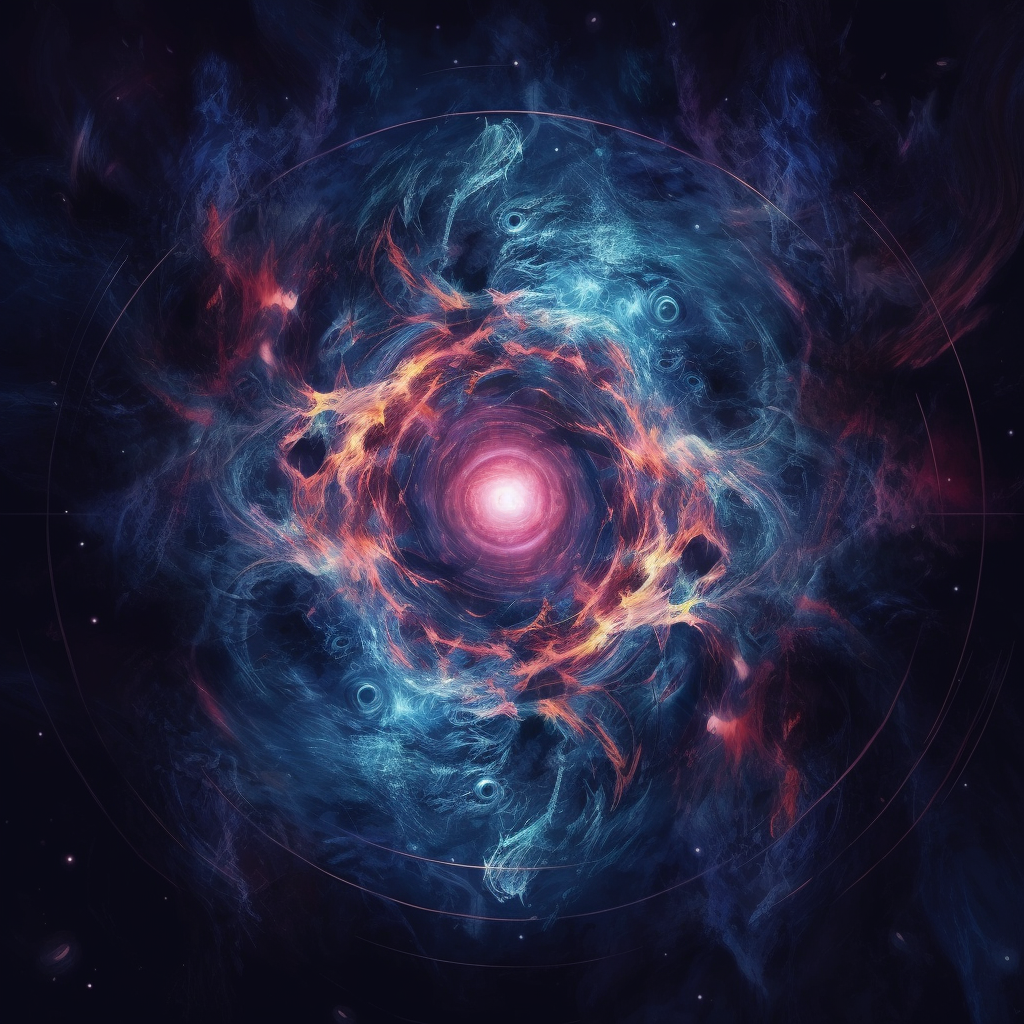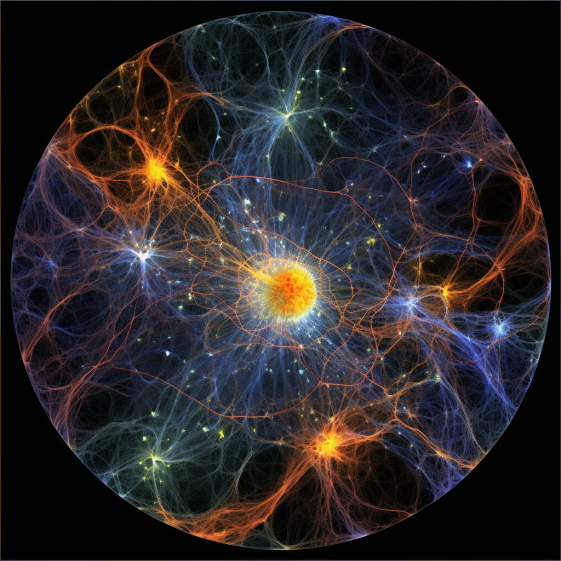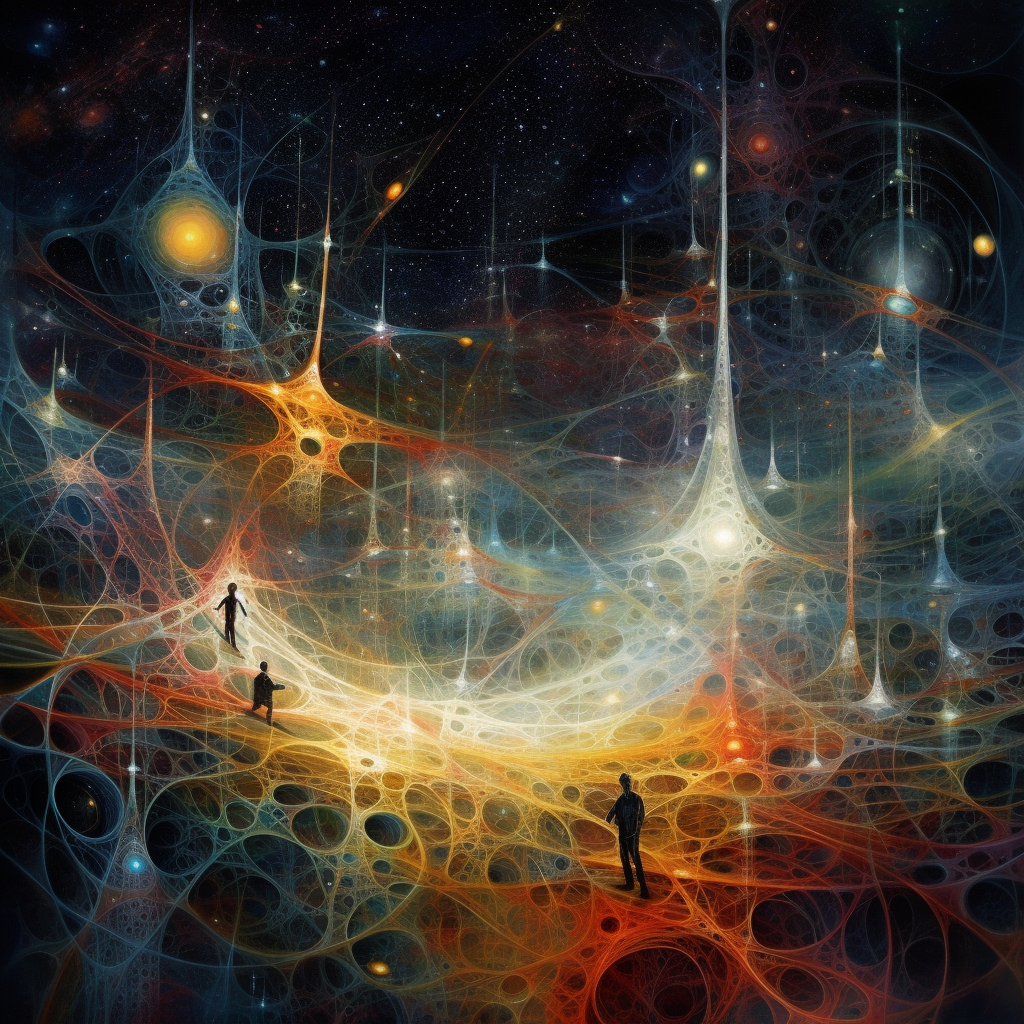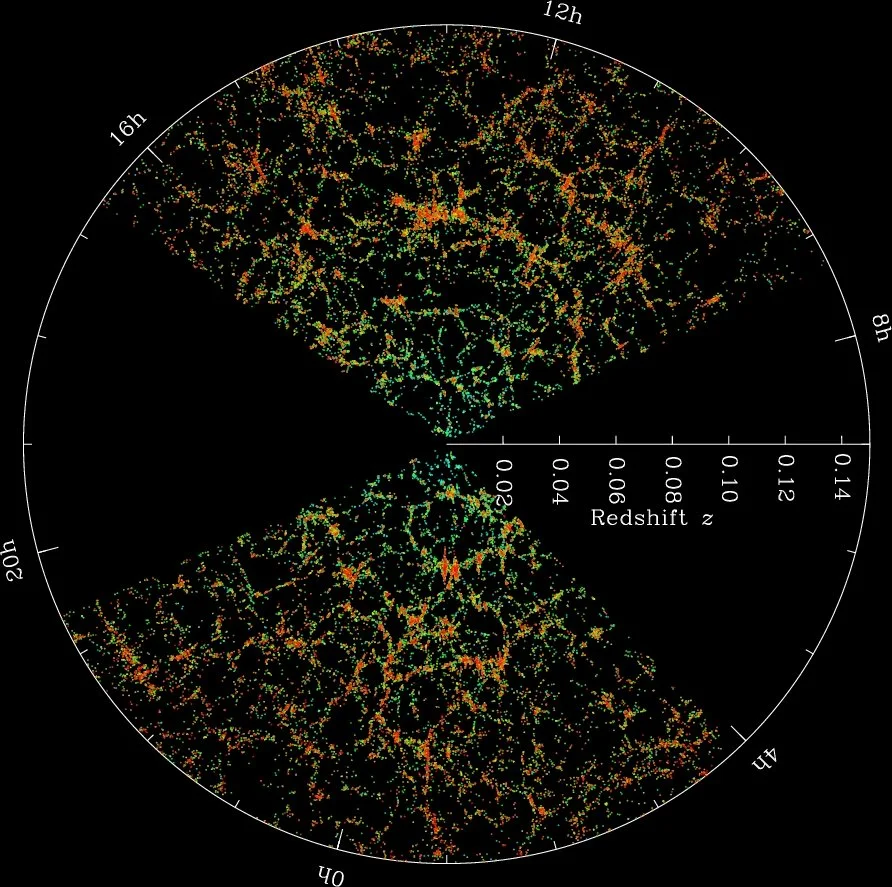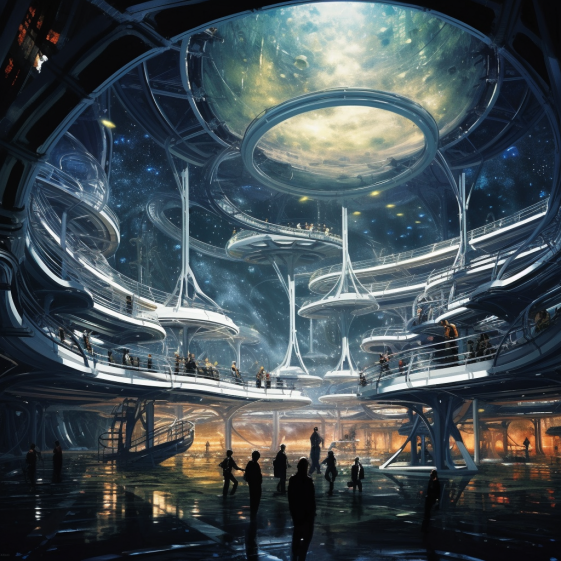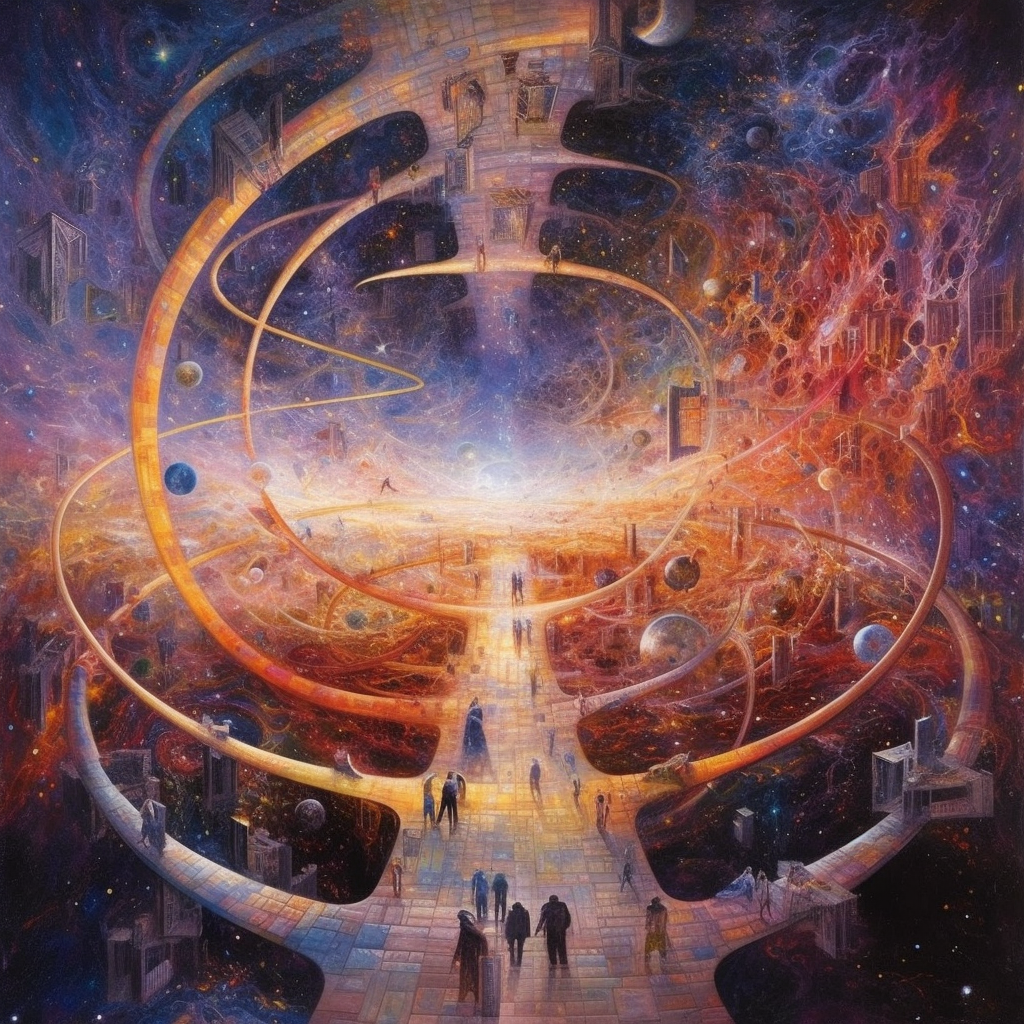The Large Scale Structure of Universe
The project aims to introducing the broad concept of LSS, takes advantages of both existing simulated images and AI images generated based on my understanding of the subjects. Also come out with an science fiction brief based on the concept with AI generated concept arts, making the abstract cosmology communicative to the general audiences.
Imagine, for a moment, that the universe is a majestic symphony, with each instrument representing a celestial body or cosmic force. The harmonious interplay between these celestial instruments weaves a grand cosmic tapestry, each thread representing the connections between stars, galaxies, and the invisible dark matter that binds them. This is the Large Scale Structure (LSS) of the universe, a complex and intricate network that spans the vastness of the cosmos, guiding the celestial dance of galaxies, stars, and interstellar gas.
Much like the notes in a symphony, the LSS is a harmonious blend of individual components working together to create a beautiful cosmic arrangement. Just as the string section of an orchestra provides the foundation for a musical masterpiece, cosmic filaments form the backbone of the LSS. The interplay of superclusters and voids, akin to the crescendos and pauses in a musical score, further enriches this celestial symphony.
As we delve into the captivating world of the LSS, let us be mindful of the delicate balance and interconnectedness that sustain life and the beauty of the universe. For it is in understanding the grand cosmic tapestry that we gain a deeper appreciation for our place within it and our role in preserving the celestial harmony that resonates throughout the cosmos.
Superclusters, vast conglomerations of galaxies bound together by gravity, are among the largest known structures in the universe. These awe-inspiring gatherings of celestial bodies are a prominent feature within the LSS, spanning millions of light-years across. Superclusters are home to countless galaxies, each teeming with stars, planets, and the potential for life. The Laniakea Supercluster, which includes our own Milky Way galaxy, is just one example of these colossal structures.
In contrast, voids are vast, empty regions of space that contain very little matter. These seemingly desolate areas can span hundreds of millions of light-years across, constituting a significant portion of the universe's volume. Voids, together with superclusters, create a complex and interconnected network within the LSS. Although they may appear barren, voids are essential in understanding the distribution of matter throughout the universe, and they provide unique opportunities for studying the cosmic microwave background radiation - the remnants of the Big Bang.
A Science Fiction World Building Using the Concept of LSS
Dictionary about Mind-blowing Facts about the LSS:
Cosmic Filaments:
These immense structures stretch across hundreds of millions of light-years, forming the backbone of the cosmic web. They are made up of galaxy clusters and interstellar gas, serving as the birthplace for new stars and galaxies.
Superclusters:
Among the largest known structures in the universe, superclusters are immense conglomerations of galaxies bound together by gravity. The Milky Way, our home galaxy, is part of the Virgo Supercluster, which itself spans more than 100 million light-years across.
Voids:
These vast, empty regions of space can span hundreds of millions of light-years across, with very few galaxies or other forms of matter present. Voids account for a significant portion of the universe's volume, and their formation is a natural consequence of the distribution of matter in the LSS.
Generally speaking, the Large Scale Structure of the universe is a captivating and intricate cosmic web that interconnects galaxies, stars, interstellar gas, and dark matter, all under the influence of gravity. This complex and ever-evolving network spans the vastness of the cosmos, providing us with invaluable insights into the origins, development, and interconnectedness of all existence.
At the core of the LSS are cosmic filaments, which serve as the backbone of the cosmic web. These immense structures stretch across hundreds of millions of light-years, connecting galaxy clusters and providing the framework upon which stars and galaxies form. The gravitational forces that shape these filaments play a crucial role in sculpting the overall structure of the universe. Filaments are not only essential in understanding the LSS but also provide valuable information about the distribution of matter on the grandest of scales.
Dark matter, although invisible, is essential in shaping the LSS. Comprising around 27% of the total mass-energy content of the universe, dark matter provides the scaffolding upon which galaxies and other cosmic structures form. Its gravitational pull is responsible for the formation of the large-scale structures we observe today. Understanding the role of dark matter in the formation and evolution of the LSS is critical for grasping the underlying forces that govern the cosmic web. As our knowledge of dark matter advances, we may unlock new technological applications and energy sources that could revolutionize our world.
Context and Time Settings
The further researches and in depth understanding has revolutionized human life in far future, leading to groundbreaking technological innovations and a deeper appreciation of the interconnectedness of all things. As the world embraced the cosmic nexus, a new era of unity and prosperity dawned.
The Grid of Galaxies
By harnessing the fundamental forces that shaped the LSS, scientists developed a revolutionary transportation network called the Grid of Galaxies. This system enabled faster-than-light travel, connecting civilizations across the cosmic web, and ushering in an age of interstellar exploration and collaboration.
The Void Engineers
The vast voids within the LSS, once considered empty and desolate, were transformed into fertile grounds for innovation. The Void Engineers, an elite group of architects and visionaries, constructed colossal energy-harvesting structures, tapping into the untapped potential of these cosmic spaces to power entire galaxies.
The Dark Matter Revolution
A deeper understanding of dark matter, the invisible substance that played a crucial role in shaping the LSS, led to the discovery of exotic new energy sources. This Dark Matter Revolution provided humanity with nearly limitless power, eliminating scarcity and enabling universal access to resources and technology.
The Harmonic Society
Inspired by the delicate balance of the LSS, human societies reorganized themselves into a global, harmonic society that valued cooperation, sustainability, and the interconnectedness of all things. War and conflict became relics of the past, as humanity embraced its place within the cosmic web and sought to protect and preserve its fragile balance.
The Sentient Cosmos
As the cosmic nexus continued to influence human life, a breakthrough in the field of astro-consciousness revealed that the universe itself was a sentient, intelligent entity. This revelation fostered a profound connection between humanity and the cosmos, inspiring a new spiritual awakening that transcended traditional beliefs and united people across the stars.
As the universe expands, the LSS evolves, with new galaxies forming and older ones merging or being torn apart by gravitational forces. This dynamic process allows astronomers to study the history and development of the universe, as well as the intricate cosmic ballet that unfolds across the vast expanse of space. As we continue to unravel the mysteries of the LSS, we stand on the threshold of countless discoveries that have the potential to reshape our understanding of the cosmos and our place within it. By studying the LSS, we would have a better understanding of the structure within the universe, particle physics, which ultimately, like the research on artificial neural networks and neuroscience, has led us into a question that cosmologists has been trying to prove: whether it is possible to represent and find the pattern of the universe.
Story Boarding
Dark Matter:
Although we cannot directly observe it, dark matter plays a crucial role in shaping the LSS. It is believed to make up around 27% of the total mass-energy content of the universe, providing the scaffolding upon which galaxies and other cosmic structures form.
Cosmic Evolution:
The LSS is not static but constantly evolving over time. As the universe expands, the cosmic web evolves, with new galaxies forming and older ones merging or being torn apart by gravitational forces. This dynamic process allows astronomers to study the history and evolution of the universe.

